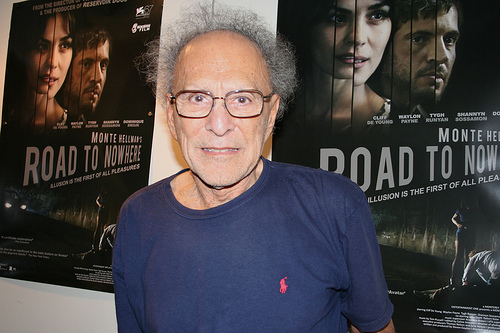
Midway through Monte Hellman’s noirish head-scratcher Road to Nowhere, an actress asks a director a seemingly simple question:
“How many movies have you seen?”
“You shouldn’t really ask a filmmaker that,” the director replies, gently scolding his leading lady. “We don’t want people to know how much time we spend obsessing over other people’s dreams.”
Road to Nowhere is Hellman’s first full-length feature — or cinematic dream, if you prefer — in two decades, and I’ve been obsessing over it for more than a week now. I saw the film three times during its limited run in New York City, and wouldn’t turn down the opportunity to watch it again. I’m not sure if I’ve ever seen a movie three times in nine days, not even Star Wars in 1977. But I’m also not sure if I’ve ever seen a movie exactly like Road to Nowhere.
Like Double Indemnity and its genre brethren, Road to Nowhere begins in the aftermath of a crime. Sexy blogger Nathalie Post (Dominique Swain, the titular nymph of Adrian Lyne’s Lolita) interviews Hollywood director Mitchell Haven (Tygh Runyan) about his film version of a notorious North Carolina murder mystery — an insurance fraud that left multiple people dead and multiple millions missing. As Hellman unwinds the narrative, we discover that not only are the dead people not actually dead, one of them may be starring in the movie under an assumed identity, playing the fictional version of herself.
If traditional noir tells stories in “Real Time” and “Remembered Time” (a.k.a. flashbacks), Road to Nowhere adds a third dimension: “Movie Time,” the cinematic reality of the docudrama being shot by the lead characters. These three planes of existence intermingle engagingly for two hours until the surprising climax, when they collide in a resolution that creates more confusion than it dispels.
“Movie Time is over,” the antagonist announces, whipping a gun out of his jacket and aiming it at the director and the actress.
And he’s right. Movie Time is over, until Hellman adds yet another narrative skin to the onion — a Hail Mary pass that, depending upon your perspective, creatively makes or breaks the film. Upon each viewing I changed my opinion of the ending, as well as what actually happened leading up to it. And I’m pretty sure Hellman would be comfortable with that.

I first saw Road to Nowhere at the Walter Reade Theater in New York City on June 8, during a Film Society of Lincoln Center salute to Hellman. In a post-screening Q&A, the 78-year-old director described the film as a “group subconscious effort” among his cast and crew and an effort to “relinquish control” after a long career as a control freak.
“In many ways I think I’m a skinny Hitchcock,” he told the audience. “But in many ways I’m different. He liked to visualize the whole thing before he started. I don’t want to know what it’s going to be like. I want to be surprised every day on the set.”
Hellman praised the contributions of editor Celine Ameslon, who both simplified Steven Gaydos’s complex script and added a profound level of complication to it with a singularly audacious editorial decision. Though he blessed it, Hellman confessed that there was creative disagreement regarding Amelson’s approach to the climax.
“Everyone kept saying, ‘You can’t do that! That destroys any reality!'” Hellman said. “But those are the kinds of battles and arguments that make movies interesting.”
You can decide for yourself what’s real and what’s not when Road to Nowhere is released on DVD and Blu-Ray on August 23. I know what I think, and I’m not telling. But Monte Hellman’s take on this cinematic dream is pretty much summed up in the final line of the closing credits:
“This film is a true story.”
2 Comments
Leave a Comment
You must be logged in to post a comment.
RIP Monte Hellman
Monte Hellman, a true American maverick of film.